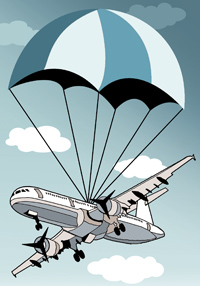INDIAN ARMED FORCES CHIEFS ON
OUR RELENTLESS AND FOCUSED PUBLISHING EFFORTS

SP Guide Publications puts forth a well compiled articulation of issues, pursuits and accomplishments of the Indian Army, over the years

I am confident that SP Guide Publications would continue to inform, inspire and influence.

My compliments to SP Guide Publications for informative and credible reportage on contemporary aerospace issues over the past six decades.
Train Well to Rein Error

Three mishaps in America, and yet another in Tokyo, have drawn the spotlight firmly on the key issues that need to be addressed when training cockpit crew—the ultimate guardians of civil aviation safety
For the US, jinxed appears to sadly be the apt prefix for 2009. Grappling with shrinking finances and swelling unemployment numbers, beleaguered Americans were further rattled by the astonishing frequency with which airplanes came crashing down even before the year had gathered momentum. Three flights—two scripting disasters and one miraculously saved—crashed in as many months. While 155 on board the US Airways Airbus A320 that ditched in the Hudson River on January 15 were lucky to survive, barely a month later, 50 were killed when a Dash-8 Q400 Continental Flight 3407 careened headlong into a house while approaching to land at Buffalo-Niagara airport. More recently, on March 22, the Pilatus PC-12 disaster in Montana claimed 14 lives. Beyond its borders, another major accident featured an American aircraft. Attempting to land amid gale force winds and severe gusty conditions in Tokyo’s Narita International Airport, an MD-11F owned by FedEx bounced and turned turtle, bursting into flames. The sole occupants onboard—the captain with over 12,000 hours and the co-pilot with 6,300 hours in their log books—perished in the inferno that engulfed the wreckage.
In all the four cases, the primary cause appears to be external to the aircraft. In the Hudson episode, it was a case of both the engines simultaneously ingesting large birds, leading to total loss of thrust. In a remarkable demonstration of capability as Commander of an airliner, excellent professional skills and sound training, the pilot managed to save lives and avert a tragedy. The two other accidents inside the US appear to have been caused by icing conditions.
The fatalities, however, seem to have been brought about by human error or poor judgement. Crew of Q400 continued to use autopilot in severe icing conditions against the more prudent option of taking over controls and flying manually. In the case of the PC-12, the single engine aircraft which encountered icing conditions was also reported to be overloaded—14 were onboard, whereas the aircraft was designed to carry only 11, including crew. The pilot had also resorted to a diversion for reasons unknown to the Air Traffic Control. In a somewhat similar fatal crash in 2005, a PC-12 was suspected to have gone down when operating under severe icing conditions, killing the five passengers onboard. The Narita crash may have been brought about by an erroneous decision not to divert but instead attempt a landing under highly adverse weather conditions of which the crew was aware.
While investigating agencies search for clues in the wreckage and delve into evidence to establish the precise cause in each case, the four accidents in quick succession have drawn the spotlight on certain key issues. First is the value of rigorous training of cockpit crew. A vital element of this process is the development of balanced judgement and the capability to take the right decisions, especially under stress and in crisis situations—attributes clearly manifested in the Hudson episode but sadly lacking in the other three. Second is the need for oversight by regulatory bodies of the conduct of civil aviation activities, and third is the critical role of the supervisory staff and the quality of in-house monitoring and supervision.
Not long ago, the Federal Aviation Administration had cracked the whip at a number of airlines in the US that had been found violating the laid down maintenance procedures. Given the fact that there are over 10,000 airliners and 300,000 General Aviation aircraft operating in the US, it is not beyond the realm of possibility that there could be similar violations or recourse to short cuts which could go undetected by the short-staffed and overworked regulatory agency.
Although miniscule in comparison to the US, the civil aviation sector in India has expanded at a phenomenal pace in the last five years. Civil aviation standards could easily be prone to dilution in the wake of such rapid expansion and, hence, it’s imperative for regulatory authorities in India to remain alert and arrest degeneration and degradation of quality standards. But while regulatory authorities bear ultimate responsibility for air safety, the real custodians of quality in civil aviation are the operating crew and the supervisory staff integral to the aviation organisations such as airlines, non-scheduled operators, flying training establishments, flying clubs or private owners. They must be trained well as it is on their shoulders that the final responsibility for civil aviation safety must rest.





